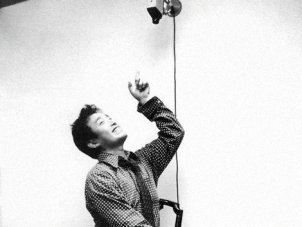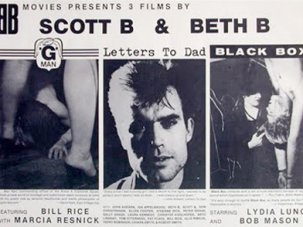Web exclusive
Excerpts from Words of the Chairman (Harun Farocki, 1967), a cinematic demonstration of weaponized ideology. From the #Kurzfilmtage catalog: “The film was received at teach-ins at the main auditorium of the Freie Universität Berlin partly with thunderous applause, partly with deafening choruses of whistles.” An early instance of increasingly militant letftist film and media from late 60s to early 70s, as well as Farocki’s lifelong fascination with relationship between material and ideological realms.
— KBL
Social Media Before the Internet, the theme programme of the 2017 Oberhausen International Short Film Festival, proposed 24 works of short film and media as precursors to the Facebook/YouTube/Twitter age. I covered this historical reconsideration of social media exclusively through social media, namely Sight & Sound’s Instagram feed. This wasn’t intended to be a mere exercise in self-reflexivity, but to also put into practice what lessons social media of the past might impart on the present.
From the seminal feminist empowerment film Für Frauen – 1. Kapitel (For Women — Chapter 1) by Cristina Perincioli with a cast of real retail workers demonstrating how to organize against a sexist workplace. (Play with audio for maximum badass effect.
— KBL
Curated by German critic and media scholar Tilman Baumgärtel, the selections were largely German-based works with asides to comparable US phenomena (particularly the rise of 1970s grassroots broadcasts such as Videofreex, QUBE and Austin Community Television). While media with an explicit interest in social engagement can be found throughout the world, it was illuminating to focus on Germany as a case study in the evolution of a utopian impulse for cinema and media to help construct an ideal society – if not embody that society on its own – by enabling a more democratic and broadly empowering means of communal expression.
A New Mayor for Freiburg (1982) shows an election campaign event hijacked from the inside out. Is it a protest against politics as usual, or an early example of troll culture? When does media activism devolve into just another spectacle?
— KBL
The titles of the first two screenings, 1968 and Social Activism, reflected the series’ pronounced political edge, with early works emphasising collective mobilisation that stands in stark contrast to the hyper-individualised self-promotion that pervades contemporary social media. The series pointed to the late 60s as a starting point for when films and videos served a social media function, as the rise of portable, user-friendly recording and playback technologies enabled greater group participation in media production and circulation.
Television Greetings from West to East (1986) refugees from East Berlin send TV postcards to loved ones across the Wall, with video techniques both clever and heartfelt.
— KBL
Flash forward to 2017, where one can not only broadcast from the palm of one’s hand but has multiple options to do so within a single app. Presently Instagram features not only its trademark image feed but a ‘Stories’ feed of images lasting only 24 hours (a blatant copy of Snapchat’s signature features) as well as livestream broadcasting. I played with each option in my coverage, settling on Stories for more ephemeral moments while engaging in four livestreams (including an interview with Baumgärtel that could have been transcribed for this report had there been an option to save it. On the other hand, the lack of a record prompted us to talk more freely and intimately than we might have otherwise).
Thanks to all those who joined in this mornings livestream chat with me and Tilman Baumgärtel, programmer of Social Media Before the Internet at #kurzfilmtage — a fun experiment inspired by many historical experiments in social media showcased in this fine program.
— KBL
Indeed, the recent emphasis on ephemerality in social media, while activating a ‘stay tuned or you’ll miss it’ mindset to reinforce user engagement, creates a dilemma for those who value a lasting record of activity. When I mentioned to Oberhausen’s press manager that I’d be using Stories and livestreaming to cover the programme, her initial delight at the innovative coverage gave way to concern that there would be no lasting trace of this activity.
I did eventually learn that there is an option to save Stories recordings to one’s device. I still haven’t figured out how Livestreams can be kept, settling instead for screen captures as a keepsake of many minutes of activity. But it’s also worth asking what a live broadcast is good for in the first place, if it’s simply a new kind of two-way mirror configuring narcissism on one end and voyeurism on the other, or if it might provoke a more inspired interaction among its participants.
Screenshot of live broadcast that just concluded: super inspiring QUBE project (1980). Artist and media activist Jaime Davidovich created an interactive system for viewers to control a live TV broadcast. It’s playing Monday in the #kurzfilmtage Open Access Channels and Pirates program, which I won’t be around for. But I found it on Davidovich’s YouTube account and live streamed it off my laptop #openaccess.
— KBL
It’s a crucial question to ask when live mobile streaming, barely a year since Chewbacca Mom became the first Facebook livestream to viral, has already been employed for everything from reporting on murders to committing them in real time. These are probably not the outcomes Mark Zuckerberg envisaged, but the Oberhausen programme offers ample instances of earlier utopian experiments of social media that generate as much chaos and confusion as connectivity.
Laurie Anderson in Nam June Paik’s Good Morning, Mr. Orwell, a 1984 New Year’s Day live transmission connecting NYC to Paris to the world. #socialmediabeforetheinternet #kurzfilmtage
— KBL
Even an artist as renowned as Nam June Paik is susceptible to a Zuckerbergian fallacy of technology instantly creating community: his landmark 1984 TV simulcast Good Morning Mr. Orwell staged a cross-planetary variety show, but the result is an anything goes mish-mash of discordant performances: global television as a Tower of Babel. Subsequent attempts at universal connectivity, like the Piazza Virtuale project at Documenta 1992, feel even more disjointed and messy.
What plagues these efforts is their confusing the seductive spectacle of technology for purposeful connection; their ornamentalised displays of techno-mediated interaction are a far cry from the more focused and grounded examples from the 1970s and 80s. If this historical overview offers lessons to apply to the present, it is to notice the ways in which gratuitous elements of social media promote an ever-evolving and accelerating array of bells and whistles, and how this endless supply of options might actually nullify our capacity for genuinely thoughtful social engagement.
Just sampled program 5 of “social media before the internet” at #kurzfilmtage, with docs about 1990s media networks like BBS and the Piazza Virtuale global interactive network project (above). I’m left thinking that the 1990s are when humans became irretrievably seduced and subsumed by technology at the very point it promised new global-scale dimensions of human contact. Makes me wonder how dehumanizing and absurd today’s social media texhnologies will look like 20 years from now.
— KBL
-
The Digital Edition and Archive quick link
Log in here to your digital edition and archive subscription, take a look at the packages on offer and buy a subscription.






